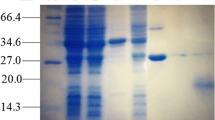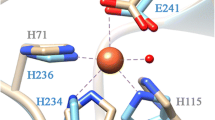Abstract
In this work, we have analyzed both at stoichiometric and at conformational level the CdII-binding features of a type 2 plant metallothionein (MT) (the cork oak, Quercus suber, QsMT). To this end four peptides, the wild-type QsMT and three constructs previously engineered to characterize its ZnII- and CuI-binding behaviour, were heterologously produced in Escherichia coli cultures supplemented with CdII, and the corresponding complexes were purified up to homogeneity. The CdII-binding ability of these recombinant peptides was determined through the chemical, spectroscopic and spectrometric characterization of the recovered clusters. Recombinant synthesis of the four QsMT peptides in cadmium-rich media rendered complexes with a higher metal content than those obtained from zinc-supplemented cultures and, consequently, the recovered CdII species are nonisostructural to those of ZnII. Also of interest is the fact that three out of the four peptides yielded recombinant preparations that included S2−-containing CdII complexes as major species. Subsequently, the in vitro ZnII/CdII replacement reactions were studied, as well as the in vitro acid denaturation and S2− renaturation reactions. Finally, the capacity of the four peptides for preventing cadmium deleterious effects in yeast cells was tested through complementation assays. Consideration of all the results enables us to suggest a hairpin folding model for this typical type 2 plant CdII-MT complex, as well as a nonnegligible role of the spacer in the detoxification function of QsMT towards cadmium.













Similar content being viewed by others
References
Cobbett CS, Goldsbrough PB (2002) Annu Rev Plant Biol 53:159–182
Grill E, Winnacker E-L, Zenk M (1985) Science 230:674–676
Grill E, Winnacker E-L, Zenk M (1987) Proc Natl Acad Sci USA 84:439–443
Dameron CT, Winge DR (1990) Inorg Chem 29:1343–1348
Cobbett C, Goldsbrough P (2000) In: Raskin I, Ensley BD (eds) Phytoremediation of toxic metals: using plants to clean up the environment. Wiley, New York, pp 247–269
Reese RN, Wagner GJ (1987) Biochem J 241:641–647
Steffens JC, Hunt DF, Williams BG (1986) J Biol Chem 261:13879–13882
Rauser WE (2000) J Plant Physiol 156:545–551
Rauser WE, Curvetto NR (1980) Nature 287:563–564
Chatthai M, Kaukinen KH, Tranbarger TJ, Gupta PK, Misra S (1997) Plant Mol Biol 34:243–254
Morris CA, Nicolaus B, Sampson V, Harwood JL, Kille P (1999) Biochem J 338:553–560
Binz PA, Kägi JHR (2001) Metallothionein. http://www.bioc.uzh.ch/mtpage/MT.html
Robinson NJ, Tommey AM, Kuske C, Jackson PJ (1993) Biochem J 295:1–10
Murphy A, Taiz L (1995) Plant Physiol 109:945–954
van Hoof NA, Hassinen VH, Hakvoort HWJ, Ballintijn KF, Schat H, Verkleij JAC, Ernst WHG, Karenlampi SO, Tervahauta AI (2001) Plant Physiol 126:1519–1526
Guo W-J, Bundithya W, Goldsbrough PB (2003) New Phytol 159:369–381
Navabpour S, Morris K, Allen R, Harrison E, Mackerness SAH, Buchanan-Wollaston V (2003) J Exp Bot 54:2285–2292
Ma M, Lau P-S, Jia Y-T, Tsang W-K, Lam SKS, Tam NFY, Wong Y-S (2003) Plant Sci 164:51–60
Zhou J, Goldsbrough PB (1994) Plant Cell 6:875–884
Lee J, Shim D, Song W-Y, Hwang I, Lee Y (2004) Plant Mol Biol 54:805–815
Zimeri AM, Dhankher OP, McCaig B, Meagher RB (2005) Plant Mol Biol 58:839–855
Gonzalez-Duarte P (2003) In: McCleverty J, Meyer TJ (eds) Metallothioneins, comprehensive coordination chemistry II, vol. 8. Elsevier, Amsterdam, pp 213–228
Tommey AM, Shi J, Lindsay WP, Urwin PE, Robinson NJ (1991) FEBS Lett 292:48–52
Kille P, Winge DR, Harwood JL, Kay J (1991) FEBS Lett 295:171–175
Bilecen K, Ozturk UH, Duru AD, Sutlu T, Petoukhov MV, Svergun DI, Koch MHJ, Sezerman UO, Cakmak I, Sayers Z (2005) J Biol Chem 280:13701–13711
Peroza EA, Freisinger E (2007) J Biol Inorg Chem (in press). doi: 10.1007/s00775-006-0195-5
Freisinger E (2007) Inorg Chim Acta 360:369–380
Cols N, Romero-Isart N, Capdevila M, Oliva B, González-Duarte P, González-Duarte R, Atrian S (1997) J Inorg Biochem 68:157–166
Capdevila M, Cols N, Romero-Isart N, González-Duarte R, Atrian S, González-Duarte P (1997) Cel Mol Life Sci 53:681–688
Mir G, Domènech J, Huguet G, Guo WJ, Goldsbrough PB, Atrian S, Molinas M (2004) J Exp Bot 55:2483–2493
Capdevila M, Domènech J, Pagani A, Tío L, Villarreal L, Atrian S (2005) Angew Chem Int Ed Engl 44:4618–4622
Domènech J, Mir G, Huguet G, Capdevila M, Molinas M, Atrian S (2006) Biochimie 88:583–593
Bongers J, Walton CD, Richardson DE, Bell JU (1988) Anal Chem 60:2683–2686
Reese RN, Winge DR (1988) J Biol Chem 262:12832–12835
Gan T, Muñoz A, Shaw III CF, Petering DH (1995) J Biol Chem 270:5339–5345
Longo VD, Gralla EB, Valentine JS (1996) J Biol Chem 271:12275–12280
Mumberg D, Müller R, Funk M (1995) Gene 156:119–122
Domènech J, Tinti A, Capdevila M, Atrian S, Torreggiani A (2007) Biopolymers (in press). doi 10.1002/bip.20729
Maret W, Vallee BL (1993) Methods Enzymol 226:52–71
Lever ABP (1986) Inorganic electronic spectroscopy, 2nd edn. Elsevier, Amsterdam
Romero-Isart N, Cols N, Termansen MK, Gelpí JL, González-Duarte R, Atrian S, Capdevila M, González-Duarte P (1999) Eur J Biochem 259:519–527
Villarreal L, Tío L, Capdevila M, Atrian S (2006) FEBS J 273:523–535
Merrifield ME, Chaseley J, Kille P, Stillman MJ (2006) Chem Res Toxicol 19:365–375
Acknowledgements
This work was supported by the Spanish Ministerio de Ciencia y Tecnología grants BIO2006-14420-C02-01 for S.A., BIO2006-14420-C02-02 for M.C. and AGL2003-00416 for M.M. G.M. and R.O. received predoctoral fellowships from the Pla de Formació de Personal Investigador del DURSI, Generalitat de Catalunya, and the Departament de Química, Universitat Autònoma de Barcelona, respectively. We especially want to acknowledge technical support from Roger Bofill and fruitful scientific discussions with Armida Torreggiani. We also thank the Serveis Científico-Tècnics de la Universitat de Barcelona (GC-FPD, ICP-AES, ESI-MS) and the Servei d’Anàlisi Química de la Universitat Autònoma de Barcelona (CD, UV–vis) for allocating instrument time.
Author information
Authors and Affiliations
Corresponding author
Electronic supplementary material
Below is the link to the electronic supplementary material.
Rights and permissions
About this article
Cite this article
Domènech, J., Orihuela, R., Mir, G. et al. The CdII-binding abilities of recombinant Quercus suber metallothionein: bridging the gap between phytochelatins and metallothioneins. J Biol Inorg Chem 12, 867–882 (2007). https://doi.org/10.1007/s00775-007-0241-y
Received:
Accepted:
Published:
Issue Date:
DOI: https://doi.org/10.1007/s00775-007-0241-y




